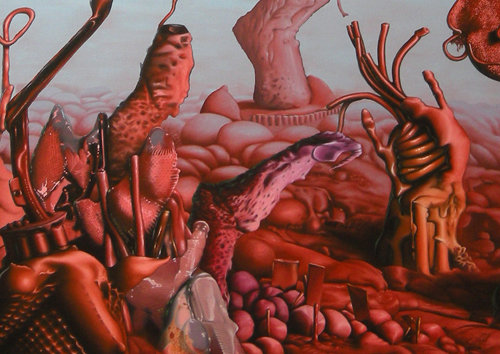Three solo exhibitions
dal 3/9/2009 al 24/9/2009
Segnalato da
3/9/2009
Three solo exhibitions
Sartorial Contemporary Art, London
A gigantic PVC banner featuring demonic swine dominates the project space dedicated to James Howard. Marcus Freeman's paintings are formal works, in the sense that although the painter is aware the subjects have meaning, his chief concern is simply to create the best image possible. The recent works by Stephen Peirce are a continuing exploration of an alternate reality, of dysfunctional parallel worlds.

Stephen Peirce
The recent works are a continuing exploration of an alternate reality, of dysfunctional parallel worlds. Scale remains a central interest in the construction of these universes. Scale, the use of a close-up viewpoint and an immersion in the detail of the forms, all lead to an ambiguity about the subject of the paintings. The resulting images present scenes that are at once familiar and strange. Rooted in the genre of Still Life, one is left trying to make sense of these other worlds or forms. Inspired in part by the fictional landscapes of film (Tarkovsky) and literature (Ballard) and by found images of the ruins of ancient civilisations, the current paintings imagine places and objects devoid of life yet pregnant with the possibility. Hovering on the edges of abstraction and surrealism the subject has evolved into an intensely personal world.
The paintings have as their origin small handheld sculptural objects made from everyday detritus; plaster, plastics, metal, cloth, electronic components, glass, wire, beads, glue and many other abject materials. Drawing on a wide range of art historical sources (including Bosch, Brueghal, Picasso, Arte Povera, De Chirico, Bacon) as well as cultural references (such as science fiction, tribal effigies, genetics, nanotechnologies) and natural forms (including micro-organisms, plant growth, disease) the resulting accumulations, spliced together in aberrant ways, allow flashes of recognition of these origins. The sculptures are then photographed in close up with theatrical lighting. The final images are the building blocks for paintings on aluminium panel and on canvas.
The inevitable corrosion, decay and destructive force of nature is always suggested in the work but so too is the notion of creation and re-growth. The forms are caught at a moment suspended between genesis and disintegration.
-----
Marcus Freeman
Marcus Freeman's paintings are formal works, in the sense that although the painter is aware the subjects have meaning, his chief concern is simply to create the best image possible. At first sight it's tempting to assume that the artist might be interested in architecture as buildings are the overwhelming subject matter. However, the paintings are really landscape paintings, they just happen to be urban landscapes. Certainly the buildings are exceptionally unremarkable architecturally – in fact they seem chosen as examples utilitarian plainness. This is quite deliberate, as any building of architectural merit or aesthetic interest would steal the show. These buildings are really just convenient, solid, immoveable objects through which to explore formal questions about the representation of three dimensional objects on canvas: how the arrangement of the few visual elements – the solid surfaces and the light and shadow – combine to describe form and create atmosphere with the greatest economy possible. As Jessica Lack wrote ‘Freeman's paintings emulate that contradiction between clarity and atmosphere'. It would not be difficult to make the canvases more atmospheric, but that would nearly always upset this balance. Peeling paint, thunderous skies and rusty iron are beautiful but imprecise elements. As it is, Freeman can measure the contribution each element makes towards these twin aims – clarity and atmosphere – having drawn not just dozens but often many hundreds of permutations.
Of course to an extent there is a deliberate manipulation of the subject matter (perhaps chiefly in the initial process of selecting which scenes to draw, and which drawings to work-up into canvases) which reveals a conscious exploitation of their meaning. In the most successful examples this is demonstrated by the ‘hard to categorise' quality of the buildings: are they work-a-day? Abandoned? Sinister? Tellingly Freeman says his ideal image would simultaneously appear as a church and a factory. Mostly they are the kind of un-heroic industrial buildings that litter our urban hinterlands – but they are rendered with the kind of reverence and grandeur that was formally reserved for the engineering triumphs of the more optimistic Modern era. That optimism – about technology, industry, about the very idea of progress is, if not entirely absent, then certainly muted in these paintings, as it is in most of our hearts.
-----
James Howard
A gigantic PVC banner featuring demonic swine dominates the project space. The gallery's relocation to the urban regeneration area that is King's Cross also marks the return of Howard's ''Lucky Lucky Dice'' Gambling Company.
''Lucky Lucky Dice'' Gambling Company's lurid, digitally enhanced poster campaigns have previously been seen in the heart of London 's economic centre, Canary Wharf. Depicting a blazing inferno of dollar signs, these works hinted at the rebranding of the recession as a mere ''credit crunch'', displayed on the very doorstep of the institutions responsible for our financial well-being. Amidst the down-turn and turmoil, a variety of ethically dubious companies have flourished, including ''Squeaky Piglet's No Problem Credit'' who provide funds for everything we want, yet can't afford. The badly photocopied loan agreements strewn on the gallery floor each demand a signature, their promise of ''Zero Percent'' is clearly an offer too good to resist or too good to be true. Just don't read the small print James Howard was born in 1981 in Canterbury. He studied at the University of Reading and The Royal Academy Schools, London. James Howard is included in the forthcoming Saatchi Gallery show: ''The Power of Paper'' and has been recently exhibited at Plastic Culture ''The Legacy of Pop'' with Andy Warhol, Jeff Koons and Takeshi Murakami.
Image: Stephen Peirce
Sartorial Contemporary (new location)
26 Argyle Square WC1H 8AP - London
Hours: Tuesday-Sarturday 12.30-6 pm.or by appointment
Admission free



